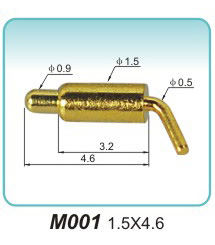source:pogo pin release time:2021-11-26 Article author:sznbone Popular:POGO PIN

With the development of the times, people's awareness of environmental protection has gradually increased, new energy vehicles have become a development trend, and the development of electrical connectors has gradually become the mainstream. The development and R&D of new energy is bound to become an irresistible trend. Electric vehicles are also an industry in which people in this field are involved. The composition of the electrical connector includes pogopin, pin jack, and spring thimble.
Pogopin as a connector as an important part of the connector, its main function is to conduct electricity and transmit information. Its function directly affects the operation of the entire connector. Therefore, the pogopin must be designed reasonably in the entire structure to achieve the basic functional significance. Below I will break it down to decompose its principle.
Bevel: In order to ensure that the needle is in contact with the needle tube 100% during work, we cut the end of the needle that contacts the spring into a bevel. This design concept can guarantee a low and stable contact impedance and can absolutely guarantee the stable conduction of the product. This design of reverse drilling is the best choice for small size connectors, which can meet the elasticity requirements of customers.
The length of the matching spring of this design can exceed the length of the needle tube. In the case of limited space, the design of reverse drilling can obtain a stable elastic stroke. The flat-bottomed design will not be inaccessible due to certain conditions on the structure of the needle and the needle tube, which will cause the current to be unable to go through the needle tube, and the wall of the needle tube will go straight along the spring, which will cause the resistance to be too large and the voltage will drop in a large arc.
Read recommendations:
How do pogo pin connector companies adjust their strategies.Magnetic Pogo Pin 16P